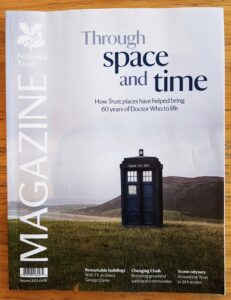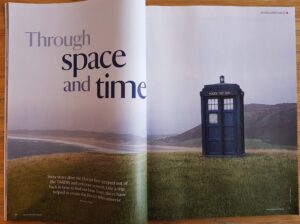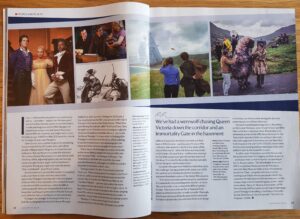 The first episode of Doctor Who was broadcast on 23 November 1963. Radio Times announced “a new Saturday-afternoon television series of adventures in time and space”. Three of the original features are still with us – the ominous theme tune by Ron Grainer, arranged by Delia Derbyshire in the BBC Radiophonic Workshop. The Tardis, a 1960s police box. And plot lines and locations as wide as the universe and beyond temporal limit.
The first episode of Doctor Who was broadcast on 23 November 1963. Radio Times announced “a new Saturday-afternoon television series of adventures in time and space”. Three of the original features are still with us – the ominous theme tune by Ron Grainer, arranged by Delia Derbyshire in the BBC Radiophonic Workshop. The Tardis, a 1960s police box. And plot lines and locations as wide as the universe and beyond temporal limit.
The National Trust is marking the anniversary with a feature in its magazine on NT properties in South Wales used in the filming of the series.
* + * + *
This is an edited version of an article I wrote for Radio Times in 2006.
I stood on top of the cliff at Southerndown on the very seat of Wales and listened hard. Far below, on the fresh hard sand, a prancing black dog chased the tide. Two matchstick people sauntered behind. A short hop across the Bristol Channel, late snow dusted the heights of Exmoor.
Then a sound. Was it the tide, or did I hear on the wind that memorable “Dum de dum, dum de dum, dum de dum” theme, against the agonized grinding and wrenching of a time lord’s police box, straining to de-materialise into the space-time continuum?
This quiet croissant of Heritage Coast, fronting the 20 miles-deep Vale of Glamorgan, was always a green and easeful place dotted with pretty little villages, even when coal was king in the begrimed industrial valleys just to the north. But if national guide books feature it less than it deserves, the location directors for the new Dr Who series knew they had found the very place.
I didn’t come across a patch of scorched grass to conclusively prove the Tardis had touched down; but one witness had already celebrated in verse a superstar’s appearance when they were filming for the new series recently. I found this Dylan Thomas-esque effort on the BBC’s own website, by adoring fan and surfer David.
“Winter deep. Cold chrome. Miss Billie Piper, her wavering golden crop … dazzled the rock pools. One moment the Bay was aflame with her warm beauty. As quick as a change in the wind…….she was gone.”
Well, that’s time travel for you. The doctor shuts the door, and they are off to some random galaxy millions of light years away. At least that’s the illusion. To cut down on travel expenses, the BBC make do with Penarth Pier and Fochriw Mountain, Barry Island and Bedlinog.
In fact the Tardis has been setting down all over South Wales for the coming series, just as it did in the last one. They compress the millennia into microseconds, and they don’t give us long to appreciate the scenery. But freeze the frame on your TV, and you will catch some splendid backgrounds from South Wales.
I found the BBC’s own website helpful. Local fans posted their sightings of the new doctor, David Tennant, and his glamorous assistant—as in “ Just seen David leaping onto a motorbike just down from my flat in Cardiff!” Then the inter-galactic censors heard about my trip. An indignant BBC lady rang me to confess they hadn’t noticed their very own site gave away so many secrets. And… For a moment I feared a duffing up by a demented wheelie bin. Or a midnight call by the Slitheen.
But all they did was add this to the website: “For security reasons we’re not putting dates to the sightings. We may also remove some specific location information.” Spoilsports. What would the last doctor (Christopher Eccleston) have made of such nannying?
Fortunately they couldn’t silence the receptionist at my Cardiff hotel. “ Dr Who? You see them filming all the time. They’ve been here, and here, here and, oh, here,” she said, planting big blue circles all over my map.
I set off up Womanby Street, where a crew had been seen last month. My advice: film here at 3pm on Cup Final day, when the roars from the adjoining Millennium Stadium would drown out any Doctor Who pyrotechnics. [FA Cup Finals were held in Cardiff during the 2000s.] The way some fans dress up these days, nobody would even notice the blue-skinned Moxx of Balhoon running around.
I crossed St Mary Street, where they often see London buses on (very long) diversion, and Billy running about in the middle of the night. In the last series, in the space of one scene, they hurtled from the London Eye to here in a moment, to show the manic mannequins breaking out of the windows of James Howells department store.
On to the Hayes, Cardiff’s stab at Parisian Street cafe culture. This is another favourite location, around the homely old pea-green refreshments booth. Then up past the castle, the original Norman keep inside the Marquis of Bute’s fairytale 19th-century battlements. In one 2005 episode they were going to demolish it to make way for a nuclear power station.

On into Cardiff’s Imperial Quarter, where Wales matches Canberra and New Delhi with elegantly spaced-out 1930s edifices in white Portland stone, marking the twilight of the British Empire. One minor masterpiece here should, by rights, have tourists queuing out of the door.
The Temple of Peace was built in 1930s as a poignant statement against a foolish world and its wars. “This place is famous, “ I reminded the custodian. “Used to be,” he said, possibly unaware that ten million would recognise it from the End of the World episode in the last series, Ecclestone and Piper strolling on its polished wood, under dove grey marble walls, to face some new threat.
My next call was down what was rough-and-raunchy Bute Street. Once you only ventured here if you had a sea cargo to dispatch, or a Shirley Bassey to sign up from Tiger Bay. But today it is as tame as a neutered tom, leading you to Wales’s bright and gleaming answer to Baltimore, Cardiff Bay.
Time for my “2001, a Space Odyssey” moment. I was tugged to the gigantic silver monolith, a continuous cascade of water down its face, in front of the Wales Millennium Centre. The BBC site again: one local cyclist reported: “approaching the silver water feature I saw the Tardis. I took photographs to show the grandchildren.”
There was an entire galaxy of past doctors next door in the Red Dragon Centre. The Dr Who Up Close exhibition celebrates the 40-year old series, from dear, quirky old Patrick Troughton, when space was still in black and white, through all his later incarnations, with props, costumes and lots of scary models.
The locations people looked wide, if not far, for backdrops that Cardiff couldn’t manage. They used the Exchange Buildings in the capital’s near neighbour Swansea for scenes in the Unquiet Dead, last year. And, thanks to a photo one passerby posted up, in the coming series I know the Tardis puts down on Worms Head, that superb natural grandstand on the Gower Peninsula.
Newport could claim the prime locations in one 2006 episode. They’ve been seen filming at Tredegar House, one of the best examples of a 17th century Charles II mansion in Britain. How many millions of us must have sailed past on the M4, blissfully unaware of this architectural gem, open to the public, half a mile off junction 28.
And full marks for setting one upcoming story – something about werewolves – around that glorious Gothic pile Craig-y-Nos just below the Brecon Beacons. The colourful Victorian diva Adelina Patti lived here, entertaining the crowned heads of Europe, and staging one of the first UK’s first car races, with a local doctor down the valley to Swansea.
I checked the website for one last essential detail, and there it was. (And don’t blame me if any of these locations end up on the cutting room floor: BBC publicity is as tight as an Auton’s handshake.) The meanest pepper pots in the universe ride again.
They been spotted, loitering with malice, in St Athans, one of the cosy, tucked-away villages in the Vale of Glamorgan. A correspondent noted: “They had Cybermen and Daleks …being filmed on the same day. Could there be a battle ahead?”
